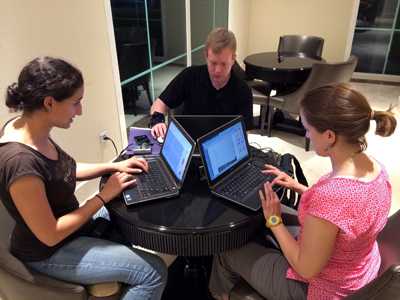CDC Disease Detectives Using New Software Tool in Ebola Hemorrhagic Fever Outbreak
This website is archived for historical purposes and is no longer being maintained or updated.
Press Release
Embargoed until: Tuesday, April 29, 2014, 12:10pm ET
Contact: Media Relations
(404) 639-3286

On the ground at the Ebola outbreak in Guinea, (From left to right) CDC disease detectives Ilana Schafer, Erik Knudsen and Andrea McCollum use the new Epi-Info software tool to track down people exposed to the deadly virus.
For the first time, Ebola hemorrhagic fever outbreak disease detectives are using a new software tool to help find people exposed to the deadly virus faster.
The new tool developed at CDC, an Epi Info viral hemorrhagic fever (VHF) application, speeds up one of the most difficult parts of disease detection: finding everyone that was exposed to, and possibly infected by, someone with a contagious disease. This task, called contact tracing, is an essential step in breaking the chain of disease transmission and ending an outbreak. In addition to facilitating contact tracing, the tool assists with the collection and management of epidemiologic, clinical, and laboratory information for every case. This data is crucial for developing outbreak countermeasures.
The Epi Info VHF tool is specifically designed for outbreaks of viral hemorrhagic fevers such as Ebola, Marburg, Rift Valley, Lassa, and Crimean-Congo hemorrhagic fevers. The open-source program runs on the Epi Info software platform that CDC has made freely available since the 1990s. It features virus transmission diagrams that help field workers visualize outbreak spread between people and automated tools that speed contact tracing and data analysis.
"With a disease as often fatal as Ebola, quickly identifying and following up with those who may have been exposed is key to saving lives and containing the outbreak," said CDC Director Tom Frieden, M.D., M.P.H. "Epi Info, the ‘Swiss Army knife’ of field-deployed epidemiologists, can now help to track disease more quickly."
CDC began development of the VHF application for Epi Info after the 2012 Ebola and Marburg hemorrhagic fever outbreaks in Uganda and the Democratic Republic of the Congo (DRC). Upon returning from the field, CDC Epidemic Intelligence Service (EIS) Officer Ilana Schafer, D.V.M., M.S.P.H., approached CDC’s Epi Info team, saying, "There has to be a better way to do this. People are dying and we can’t collect, analyze, and act on the data fast enough."
Schafer worked on four outbreak responses in 2012 – three Ebola outbreaks and one Marburg outbreak. She was responsible for creating and maintaining centralized databases for all case epidemiologic, clinical, and laboratory information collected by international response partners, including Ministries of Health, Doctors without Borders (Médécins sans Frontières), CDC, and the World Health Organization (WHO), during three of the outbreaks. She was on the CDC/WHO team recently deployed to Guinea for the West Africa Ebola outbreak, along with CDC Epi Info software developer Erik Knudsen, who is tweaking the new VHF tool on the ground as needed.
"As Ebola outbreaks are rare, this is the first time we’re getting to put this tool through its paces," said CDC Epi Info team lead Asad Islam, M.S. "Given that the Epi Info VHF tool has a tiny IT footprint and easily works in places with limited network connectivity, that it automatically updates as new information is added, and that it offers daily reports to guide follow-up, we are cautiously optimistic that it will make a significant difference."
An earlier version of the Epi Info VHF tool was presented in Uganda in September of 2013 to the Ugandan Ministry of Health, Doctors without Borders, and WHO; they provided valuable feedback that was incorporated into the current version.
Epi Info software is used globally for rapidly assessing disease outbreaks and for speeding disease detection and response. Developing the VHF tool on the Epi Info platform was far more timely and cost-effective than contracting for development of a specialized system. In addition, once finalized as a standard feature and added to Epi Info, the tool will be available cost-free to be adapted for future public health needs.
This innovation was the result of collaboration between CDC’s Epi Info team in the Center for Surveillance, Epidemiology, and Laboratory Services and the Viral Special Pathogens Branch in the National Center for Emerging and Zoonotic Infectious Diseases. It coincides with the launch of the U.S. government’s Global Health Security Agenda to strengthen national security by helping other nations prevent, detect, and effectively respond to disease outbreaks. Over the next five years, the initiative will strengthen the health infrastructure of at least 30 partner countries with 4 billion citizens. CDC has invested $40 million this year in the effort and President Barack Obama has requested an additional $45 million in his 2015 budget request toward this purpose.
Ebola virus is transmitted through direct physical contact with body fluids of an infected person including blood, saliva, stool, urine, and sweat, as well as direct physical contact with objects that have been contaminated by the infected body fluids, such as needles and soiled linens. Outbreaks can spread rapidly, with easily misdiagnosed initial symptoms such as fever, body aches, diarrhea and vomiting and an incubation period as brief as two days and as long as three weeks.
CDC Disease Detective Ilana Schafer, recently returned from the Guinea Ebola outbreak, will speak on the new Epi-Info tool at the EIS conference today at 12:10pm ET.
For more information about the current outbreak of Ebola in Guinea and Liberia, see http://www.cdc.gov/vhf/ebola/outbreaks/guinea/.
For more information about Epi Info, see www.cdc.gov/epiinfo.
- Page last reviewed: April 29, 2014 (archived document)
- Content source:
Error processing SSI file


 ShareCompartir
ShareCompartir